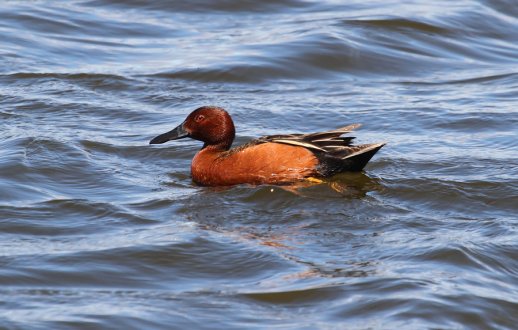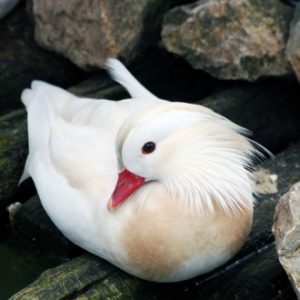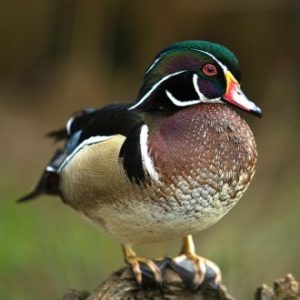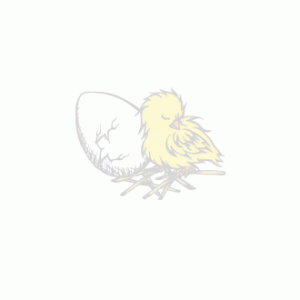The male Cinnamon Teal Duck, Anas cyanoptera, is one of the most recognizable species of ducks, with a pure bright cinnamon color over their heads, necks, and bodies. Bills are black and legs and feet are yellow. The shoulders and upper forewings have a dramatic powder-blue patch. The top of the head and wings are a dark umber color with a green sheen.
Females are pretty with their dark eyes and bills set into their earthy mix of chestnut and brown colors, perfect for blending into their surroundings. Males in eclipse and young birds resemble females in coloration.
Range: Cinnamon Teal Ducks have a wide range throughout western North America and South America.
Habitat: Cinnamon Teal are migratory, and their breeding habitat is usually marshes and wetlands of the western U.S., although they are sometimes seen as far north as southern Canada. In the winter, the birds migrate to swamps and slow-moving waters in South America.
Status in the Wild: The current population of Cinnamon Teal is stable, and they are classified as being of Least Concern in Conservation Status.
Status in Aviculture: Cinnamon Teal make fine aviary birds, are not aggressive with other species, and do well in captivity.
Breeding: Cinnamon Teal usually chose a new mate every year and are not monogamous. Males attain their breeding plumage by the fall of their first year. Male and female Cinnamon Teal are fertile in their first year. Cinnamon Teal are ground nesters and materials or a nest box should be provided at ground level. Breeding season is in the spring and clutches consist of 8-12 eggs. Eggs are incubated for about 25 days.
Lifespan: Cinnamon Teal have been known to live up to 20 years in a well-maintained captive environment.
Size: Cinnamon Teal are 14-17 inches in length with a wingspan of between 24 and 30 inches. They weigh 14-15 ounces.
Housing Requirements: As dabbling ducks, Cinnamon Teal will do best if provided with a substantial body of water for foraging. They are good flyers and can take off directly from the water, so an enclosure will be necessary both to keep them contained, or if wings are clipped, and to keep them protected from predators.
Diet: In the wild, Cinnamon Teal eat a diverse diet from the water including aquatic plants, seeds, insects, and mollusks. Cinnamon Teal are dabbling ducks, but unlike mist dabblers, they tend to skim the surface of the water with their bills. They would do well on a high-quality commercial waterfowl or game bird diet.
Miscellaneous Notes: Cinnamon Teals are the only waterfowl that breed in both North and South America.




